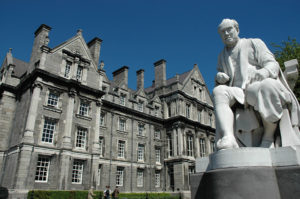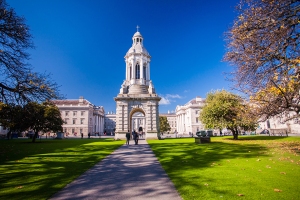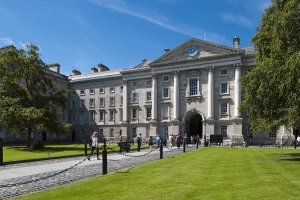Trinity College, Dublin
Trinity College, officially the College of the Holy and Undivided Trinity of Queen Elizabeth near Dublin, is the sole constituent college of the University of Dublin, a research university located in Dublin, Ireland. The college was founded in 1592 by Queen Elizabeth I as the “mother” of a new university, modelled after the collegiate universities of Oxford and Cambridge, but unlike these other ancient universities, only one college was ever established; as such, the designations “Trinity College” and “University of Dublin” are usually synonymous for practical purposes. It is one of the seven ancient universities of Britain and Ireland, as well as Ireland’s oldest surviving university.
 Trinity College is widely considered to be the most prestigious university in Ireland, and amongst the most elite in Europe. This is principally due to its extensive history, highly competitive admissions procedure, reputation with social elitism and unique relationship with both the University of Oxford and the University of Cambridge. In accordance with the formula of ad eundem gradum, a form of recognition that exists among the three universities, a graduate of Oxford, Cambridge, or Dublin can be conferred with the equivalent degree at either of the other two universities without further examination. Trinity College, Dublin is a sister college to St. John’s College, Cambridge and Oriel College, Oxford.
Trinity College is widely considered to be the most prestigious university in Ireland, and amongst the most elite in Europe. This is principally due to its extensive history, highly competitive admissions procedure, reputation with social elitism and unique relationship with both the University of Oxford and the University of Cambridge. In accordance with the formula of ad eundem gradum, a form of recognition that exists among the three universities, a graduate of Oxford, Cambridge, or Dublin can be conferred with the equivalent degree at either of the other two universities without further examination. Trinity College, Dublin is a sister college to St. John’s College, Cambridge and Oriel College, Oxford.
Originally it was established outside the city walls of Dublin in the buildings of the outlawed Catholic Augustinian Priory of All Hallows. Trinity College was set up in part to consolidate the rule of the Tudor monarchy in Ireland, and as a result was the university of the Protestant Ascendancy for much of its history. While Catholics were admitted from 1793 certain restrictions on membership of the college remained as professorships, fellowships and scholarships were reserved for Protestants. This restrictions were lifted by Act of Parliament in 1873. However from 1871 to 1970, the Catholic Church in Ireland in turn forbade its adherents from attending Trinity College without permission. Women were first admitted to the college as full members in January 1904.
Trinity College is now surrounded by Dublin and is located on College Green, opposite the historic Irish Houses of Parliament. The college proper occupies 190,000 m2 (47 acres), with many of its buildings ranged around large quadrangles (known as ‘squares’) and two playing fields. Academically, it is divided into three faculties comprising 25 schools, offering degree and diploma courses at both undergraduate and postgraduate levels.
The Library of Trinity College is a legal deposit library for Ireland and the United Kingdom, containing over 6.2 million printed volumes and significant quantities of manuscripts, including the Book of Kells.
Early history
The first University of Dublin (known as the Medieval University of Dublin and unrelated to the current university) was created by the Pope in 1311, and had a Chancellor, lecturers and students (granted protection by the Crown) over many years, before coming to an end at the Reformation.
Following this, and some debate about a new university at St. Patrick’s Cathedral, in 1592 a small group of Dublin citizens obtained a charter by way of letters patent from Queen Elizabeth incorporating Trinity College at the former site of All Hallows monastery, to the south east of the city walls, provided by the Corporation of Dublin. The first Provost of the College was the Archbishop of Dublin, Adam Loftus (after whose former college at Cambridge the institution was named), and he was provided with two initial Fellows, James Hamilton and James Fullerton. Two years after foundation, a few Fellows and students began to work in the new College, which then lay around one small square.
During the following fifty years the community increased the endowments, including considerable landed estates, were secured, new fellowships were founded, the books which formed the foundation of the great library were acquired, a curriculum was devised and statutes were framed. The founding Letters Patent were amended by succeeding monarchs on a number of occasions, such as by James I in 1613 and most notably in 1637 by Charles I (who increased the number of fellows from seven to sixteen, established the Board – then the Provost and the seven senior Fellows – and reduced the panel of Visitors in size) and supplemented as late as the reign of Queen Victoria (and later still amended by the Oireachtas in 2000).
18th and 19th centuries
During the eighteenth century Trinity College was seen as the university of the Protestant Ascendancy. Parliament, meeting on the other side of College Green, made generous grants for building. The first building of this period was the Old Library building, begun in 1712, followed by the Printing House and the Dining Hall. During the second half of the century Parliament Square slowly emerged. The great building drive was completed in the early nineteenth century by Botany Bay, the square which derives its name in part from the herb garden it once contained (and which was succeeded by Trinity College’s own Botanic Gardens). Following early steps in Catholic Emancipation, Catholics were first allowed to apply for admission in 1793, prior to the equivalent change at the University of Cambridge and the University of Oxford. Certain disabilities remained. In December 1845 Denis Caulfield Heron was the subject of a hearing at Trinity College. Heron had previously been examined and, on merit, declared a scholar of the college but had not been allowed to take up his place due to his Catholic religion. Heron appealed to the Courts which issued a writ of mandamus requiring the case to be adjudicated by the Archbishop of Dublin and the Primate of Ireland. The decision of Richard Whately and John George de la Poer Beresford was that Heron would remain excluded from Scholarship. This decision confirmed that the legal position remained that persons who were not Anglicans (Presbyterians were also affected) could not be elected to Scholarship, Fellowship or be made a Professor. However within less than three decades of this all disabilities imposed on Catholics were repealed as in 1873, all religious tests were abolished, except for entry to the divinity school. However, the Irish Catholic bishops responding to the increased ease, due to these changes, with which Catholics could attend an Institution which the Bishops saw as thoroughly Protestant in ethos, and in light of the establishment of the Catholic University, in 1871 implemented a general ban on Catholics entering Trinity College, with few exceptions. “The ban” despite its longevity, is associated in the popular mind with Archbishop of Dublin John Charles McQuaid as he was made responsible for enforcing the ban from 1956 until it was rescinded by the Catholic Bishops of Ireland in 1970, shortly before McQuaid’s retirement. Prior to 1956 it was the responsibility of the local Bishop.
The nineteenth century was also marked by important developments in the professional schools. The Law School was reorganised after the middle of the century. Medical teaching had been given in the College since 1711, but it was only after the establishment of the school on a firm basis by legislation in 1800, and under the inspiration of one Macartney, that it was in a position to play its full part, with such teachers as Graves and Stokes, in the great age of Dublin medicine. The Engineering School was established in 1842 and was one of the first of its kind in Ireland and Britain.
20th century
In April 1900, Queen Victoria visited College Green in Dublin.
Women were admitted to Trinity College as full members for the first time in 1904. For the period from 1904 to 1907, women from Oxford and Cambridge came to Trinity College to receive their ad eundem degree and were known as Steamboat ladies.
In 1907, the Chief Secretary for Ireland proposed the reconstitution of the University of Dublin. A “Dublin University Defence Committee” was created and was successful in campaigning against any change to the status quo, while the Catholic bishops’ rejection of the idea ensured its failure among the Catholic population. Chief among the concerns of the bishops was the remains of the Catholic University of Ireland, which would become subsumed into a new university, which on account of Trinity College would be part Anglican. Ultimately this episode led to the creation of the National University of Ireland. Trinity College was one of the targets of the Volunteer and Citizen Army forces during the 1916 Easter Rising but was successfully defended by a small number of unionist students most of whom were members of the University Officers’ Training Corps. From July 1917 until March 1918 the Irish Convention met in the College in an attempt to address the political aftermath of the Easter rising. (Subsequently, following the failure of the Convention to reach “substantial agreement”, the Irish Free State was set up in 1922.) In the post-independence period Trinity College suffered from a cool relationship with the new state. On 3 May 1955 the Provost, Dr A.J.McConnell, pointed out in a piece in the Irish Times that certain state-funded County Council scholarships excluded Trinity College from the list of approved institutions. This, he suggested, amounted to religious discrimination, which was forbidden by the constitution.
The School of Commerce was established in 1925, and the School of Social Studies in 1934. Also in 1934, the first female professor was appointed.
1958 saw the first Catholic to reach the Board of Trinity as a Senior Fellow.
In 1962 the School of Commerce and the School of Social Studies amalgamated to form the School of Business and Social Studies. In 1969 the several schools and departments were grouped into Faculties as follows: Arts (Humanities and Letters); Business, Economic and Social Studies; Engineering and Systems Sciences; Health Sciences (since October 1977 all undergraduate teaching in dental science in the Dublin area has been located in Trinity College); Science.
In 1970 the Catholic Church lifted its ban on Catholics attending the college without special dispensation. At the same time, the Trinity College authorities invited the appointment of a Catholic chaplain to be based in the college. There are now two such Catholic chaplains.
In the late 1960s, there was a proposal for University College, Dublin, of the National University of Ireland, to become a constituent college of a newly reconstituted University of Dublin. This plan, suggested by Brian Lenihan and Donogh O’Malley, was dropped after opposition by Trinity College students.
From 1975, the Colleges of Technology that now form the Dublin Institute of Technology had their degrees conferred by the University of Dublin. This arrangement was discontinued in 1998 when the DIT obtained degree-granting powers of its own.
The School of Pharmacy was established in 1977 and around the same time, the Faculty of Veterinary Medicine was transferred to University College, Dublin. Student numbers increased sharply during the 1980s and 1990s, with total enrolment more than doubling, leading to pressure on resources and subsequent investment programme.
1991 saw Thomas Noel Mitchell become the first Roman Catholic elected Provost of Trinity College.
21st century
Trinity College is today in the centre of Dublin. At the beginning of the new century, it embarked on a radical overhaul of academic structures to reallocate funds and reduce administration costs, resulting in, for instance, the mentioned reduction from six to five to eventually three faculties under a subsequent restructuring by a later governing authority. The ten-year strategic plan prioritises four research themes with which the College seeks to compete for funding at the global level. Comparative funding statistics reviewing the difference in departmental unit costs and overall costs before and after this restructuring are not however apparent. The Hamilton Mathematics Institute in Trinity College, named in honour of William Rowan Hamilton, was launched in 2005 and aims to improve the international profile of Irish mathematics, to raise public awareness of mathematics and to support local mathematical research through workshops, conferences and a visitor programme.
This article uses material from the Wikipedia article “Trinity College, Dublin”, which is released under the Creative Commons Attribution-Share-Alike License 3.0.




